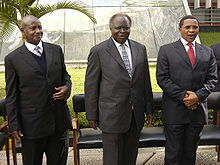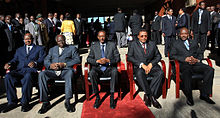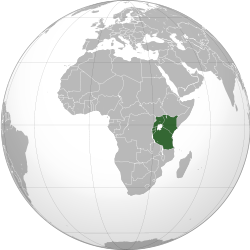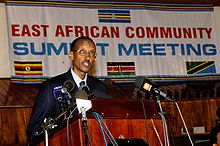- East African Community
-
East African Community -
Jumuiya ya Afrika ya Mashariki (Swahili) -
Communauté d'Afrique de l'Est (French)

Headquarters Arusha Demonym East African Member States Leaders - East African Summit Pierre Nkurunziza - The Secretariat Richard Sezibera - East African Legislative Assembly Abdi Abdirahin - Council of Ministers Mwai Kibaki (Kenya) Legislature East African Legislative Assembly Area - Total 1,817,945 km2
701,028 sq miPopulation - 2009 estimate 131,862,000 - Density 72.5/km2
187.8/sq miGDP (PPP) 2007 estimate - Total US$ 149 billion - Per capita US$1,200 GDP (nominal) 2007 estimate - Total US$ 61 billion - Per capita US$488 HDI  - (medium) (-)
- (medium) (-)Currency 5- Kenyan shilling (KES)1
- Tanzanian shilling (TZS)1
- Ugandan shilling (UGX)1
- Burundi franc (BIF)
- Rwandan franc (RWF)
Time zone EAT (UTC+ 3) Website
www.eac.int1 To be replaced by the East African shilling between 2011 and 2015. The East African Community (EAC) is an intergovernmental organisation comprising the five east African countries Burundi, Kenya, Rwanda, Tanzania, and Uganda.[1] Pierre Nkurunziza, the President of the Republic of Burundi, is the current Chairman of the East African Community. The EAC was originally founded in 1967, collapsed in 1977, and was officially revived on July 7, 2000.[2] In 2008, after negotiations with the Southern Africa Development Community (SADC) and the Common Market for Eastern and Southern Africa (COMESA), the EAC agreed to an expanded free trade area including the member states of all three. The EAC is one of the pillars of the African Economic Community.
The EAC is a potential precursor to the establishment of the East African Federation, a proposed federation of its five members into a single state. In 2010, the EAC launched its own common market for goods, labour and capital within the region, with the goal of a common currency by 2012 and full political federation in 2015.[3]
The East African region covers an area of 1.8 million square kilometres with a combined population of about 132 million (July 2009 est.)[4] and has significant natural resources. Kenya and Tanzania have had a relatively peaceful history since achieving independence, in contrast to the wars and civil strife that have occurred in Rwanda, Burundi, and Uganda. Today, East Africa seeks to maintain stability and prosperity in the midst of ongoing conflicts in the D.R. Congo, and the Horn of Africa. The most prevalent languages of East Africa are Swahili, English, Kirundi and Kinyarwanda, although French is also common in Burundi and Rwanda.[citation needed]
Contents
History
 From left to right, President Yoweri Museveni of Uganda, President Mwai Kibaki of Kenya and President Jakaya Kikwete of Tanzania during the eighth EAC summit in Arusha, November 2006
From left to right, President Yoweri Museveni of Uganda, President Mwai Kibaki of Kenya and President Jakaya Kikwete of Tanzania during the eighth EAC summit in Arusha, November 2006
Kenya, Tanzania and Uganda have had a history of co-operation dating back to the early 20th century. The customs union between Kenya and Uganda in 1917, which the then Tanganyika joined in 1927, was followed by the East African High Commission from 1948 to 1961, the East African Common Services Organization from 1961 to 1967, and then the 1967 to 1977 East African Community.[5]
Inter-territorial co-operation between the Kenya Colony, the Uganda Protectorate and the Tanganyika Territory was first formalised in 1948 by the East African High Commission. This provided a customs union, a common external tariff, currency and postage; and also dealt with common services in transport and communications, research and education. Following independence, these integrated activities were reconstituted and the High Commission was replaced by the East African Common Services Organisation, which many observers thought would lead to a political federation between the three territories. The new organisation ran into difficulties because of the lack of joint planning and fiscal policy, separate political policies and Kenya's dominant economic position. In 1967 the East African Common Services Organisation was superseded by the East African Community. This body aimed to strengthen the ties between the members through a common market, a common customs tariff and a range of public services so as to achieve balanced economic growth within the region.[6]
In 1977, the East African Community collapsed after ten years. Causes for the collapse included demands by Kenya for more seats than Uganda and Tanzania in decision-making organs,[7] disagreements with Ugandan dictator Idi Amin, and the disparate economic systems of socialism in Tanzania and capitalism in Kenya.[8] The three member states lost over sixty years of co-operation and the benefits of economies of scale, though some Kenyan government officials celebrated the collapse with champagne.[9] Each of the former member states had to embark, at great expense and at lower efficiency, upon the establishment of services and industries that had previously been provided at the Community level.[citation needed]
Later, Presidents Moi of Kenya, Mwinyi of Tanzania, and Museveni of Uganda signed the Treaty for East African Co-operation in Arusha, Tanzania, on 30 November 1993, and established a Tri-partite Commission for Co-operation. A process of re-integration was embarked on involving tripartite programmes of co-operation in political, economic, social and cultural fields, research and technology, defence, security, legal and judicial affairs.
The East African Community was finally revived on November 30, 1999, when the Treaty for its re-establishment was signed. It came into force on July 7, 2000, twenty-three years after the total collapse of the defunct erstwhile Community and its organs. A customs union was signed in March 2004 which commenced on January 1, 2005; Kenya, the region's largest exporter, continued to pay duties on goods entering the other four countries on a declining scale until 2010. A common system of tariffs will apply to goods imported from third-party countries.
Political dimensions
It is argued that key drivers for Kenya, Tanzania and Uganda are that Kenya wishes to export surplus capital, Uganda seeks an outlet for its surplus labour and Tanzania wants to realise a Pan-African vision.[10] However, it is argued the commonalities go far deeper. Many of the national elites old enough to remember the former Community often share memories and a sharp sense of loss at its eventual dissolution.[10] More cynically, others argue this historical ambition provides the potential for politicians to present themselves as statesmen of a higher order, as representatives of a greater regional interest.[10] Furthermore, EAC institutions bring significant new powers to dispose and depose to those who serve in them.[10]
Some question the extent to which the visions of a political union are shared outside the elite and the relatively elderly, further arguing the youthful mass of the population is not well informed about the process in any of the countries,[10] while others point to an enhanced sense of East African identity developing from modern communications.[10] Commitment to the formal EAC idea is relatively narrow, in both social and generational terms, and thus many question the timetable drawn up for the project. Fast-tracking political union was first discussed in 2004 and enjoyed a consensus on the subject among the three presidents of Kenya, Tanzania and Uganda.[10] Thus, a high-level committee headed by Amos Wako of Kenya was commissioned to investigate the possibility of speeding up the process of integration so as to achieve political federation sooner than previously visualised.[10] Yet there are concerns rapid changes would allow popular reactionary politics against the project.[10] There is an argument however, that there are high costs that would be required at the beginning and that fast-tracking the project would allow the benefits to be seen earlier.[10]
There remain significant political differences between the states. Museveni's success in obtaining his third-term amendment raised doubts in the other countries.[10] The single-party dominance in the Tanzanian and Ugandan parliaments is unattractive to Kenyans, while Kenya's ethnic-politics is not apparent in Tanzania.[10] Rwanda has a distinctive political culture with a political elite committed to building a developmental state, partly in order to safeguard the Tutsi group against a return to ethnic violence.[10]
Other problems involve states being reluctant to relinquish involvement in other regional groups, e.g. Tanzania's withdrawal from COMESA but staying within the SADC bloc for the Economic Partnership Agreement negotiations with the European Union.[10] Many Tanzanians are also concerned, because creating a common market means removing obstacles to the free movement of both labour and capital.[10] Free movement of labour may be perceived as highly desirable in Uganda and Kenya, and have important developmental benefits in Tanzania, however in Tanzania there is widespread resistance to the idea of ceding land rights to foreigners, including citizens of Kenya and Uganda.[10]
While generally the member nations are largely in favor of the East African Federation,[citation needed] informal polls indicate that most Tanzanians (80% of its population) have an unfavorable view.[11] Tanzania has more land than all the other EAC nations combined, and some Tanzanians fear landgrabs by the current residents of the other EAC member nations.[12][13][14] Land scarcity is a recurring issue in East Africa, particularly in Kenya, where clashes on the Kenyan side of Mount Elgon in 2007 left more than 150 dead and forced at least 60,000 away from their homes.[15]
Expansion
Tanzania supports the expansion of the East African Community. In 2010, Tanzanian officials expressed interest in inviting Malawi, Democratic Republic of Congo and Zambia to join the EAC, but Malawian Foreign Affairs Minister Etta Banda said there were no formal negotiations taking place concerning Malawian membership.[16]
The presidents of Kenya and Rwanda invited the Autonomous Government of Southern Sudan to apply for membership upon the independence of South Sudan in 2011,[17][18] and South Sudan was reportedly an applicant country as of mid-July 2011.[19][20] As of early-October, South Sudan is said to officially become a member in the future.[21] Analysts suggested that South Sudan's early efforts to integrate infrastructure, including rail links and oil pipelines[22], with systems in Kenya and Uganda indicated intention on the part of Juba to pivot away from dependence on Sudan and toward East Africa. Reuters considers South Sudan the likeliest candidate for EAC expansion in the short term,[23] and an article in Tanzanian daily The Citizen that reported East African Legislative Assembly Speaker Abdirahin Haithar Abdi said South Sudan was "free to join the EAC" asserted that analysts believe the country will soon become a full member of the regional body.[24] On 17 September, the Daily Nation quoted a South Sudanese MP as saying that while his government was eager to join the EAC, it would likely delay its membership over concerns that its economy was not sufficiently developed to compete with EAC member states and could become a "dumping ground" for Kenyan, Tanzanian, and Ugandan imports.[25] This was contradicted by President Salva Kiir, who announced South Sudan had officially embarked on the application process one month later.[26]
Sudan has applied to join the EAC, but its membership is strongly opposed by Tanzania and Uganda, which contend that due to Sudan's lack of a direct border with the EAC, its allegedly discriminatory actions toward black Africans, its record of human rights violations, and its history of hostilities with both Uganda and candidate country South Sudan, it is ineligible to join and its application should be thrown out.[27]
Economic dimensions
Importance of the customs union
The key aspects of the customs union include:[10]
- a Common External Tariff (CET) on imports from third countries;
- duty-free trade between the member states; and
- common customs procedures.
Different rates are applied for raw materials (0%), intermediate products (10%) and finished goods (25%), the latter percentage is fixed as the maximum.[10] This represents a significance decrease from what was previously the maximum in Kenya (35%), Tanzania (40%) and Uganda (15%).[10] However, this customs union is not yet fully implemented, because there is a significant list of exclusions to the Common External Tariff and tariff-free movement of goods and services.[10] Technical work is also needed to harmonise and modernise the customs procedures in the EAC's major ports of entry.[10]
The expected revenue benefits are understood to be minimal by many analysts, based on comparative-static simulation exercises demonstrating the one-off impacts of the immediate introduction of the CU's full tariff package.[10] The findings suggest an increase in intraregional trade that is largely the result of trade diversion, not trade creation, with some aggregate welfare benefits in Kenya and Tanzania but welfare losses in Uganda.[10] From a trade-integration perspective, the EAC may not be the best chosen unit, because the current trade between the three countries is small compared to their external trade, and the EAC's 105 million citizens do not represent a large market in global terms, given the very low average incomes.[10]
Emerging business trends
Business leaders are far more positive than economists about the benefits of EAC integration, its customs union as a step in the process, as well as the wider integration under COMESA.[10] The larger economic players perceive long-term benefits in a progressively expanding regional market.[10] Pattern of regional development are already emerging, including:[10]
- Kenyan firms have successfully aligned to the lower protection afforded by the EAC CET and fears that firms would not adjust to a 25% maximum CET, or would relocate to Tanzania or Uganda have not been realised.
- An intraregional division of labour is developing that results in basic import-processing relocating to the coast to supply the hinterland. The final stages of import-processing (especially those bulky finished goods that involve high transportation costs) and natural-resource based activities, are moving up-country and up-region, either within value chains of large companies or different segments located by firms in different countries.
- Trade in goods and services has already increased as service provision to Kenyans and Tanzanians is already important for Uganda (in education and in health). Kenya exports financial services, for example via the Kenya Commercial Bank and purchase and upgrading of local operators in Tanzania, Uganda and Sudan. Uganda hopes integration will help support its tourism potential through integration with established regional circuits.
- There are signs a business culture oriented to making profits through economics of scale and not on protectionism.
Poverty reduction
East African economies have large informal sectors, unintegrated with the formal economy and large business.[10] The concerns of large-scale manufacturing and agro-processing concerns are not broadly shared by the bulk of available labour.[10] Research suggest the promised investments on the conditions of life of the region's overwhelmingly rural poor will be slight, with the significant exception of agro-industrial firms with out-grower schemes or that otherwise contribute to the coordination of smallholder production and trade.[10]
It is informal trade across borders that is most often important to rural livelihoods and a customs union is unlikely to significantly impact the barriers that this faces and taxes are still being fixed separately by countries.[10] However, the introduction of one-stop border posts being introduced and the reduction in tariff barriers are coming down progressively.[10]
The establishment of a common market will create both winners (numerous food producers and consumers on both sides of all borders) and losers (smugglers and the customs, police and local government officers who currently benefit from bribery at and around the borders) in the border areas.[10] More substantial impact could be attained by a new generation of investments in world-market production based on the region's comparative advantages in natural resources (especially mining and agriculture) and the new tariff structure creates marginally better conditions for world-market exporters, by cheapening inputs and by reducing upward pressures on the exchange rate.[10]
Common market
 EAC heads in 2009: from left to right, Yoweri Museveni of Uganda, Mwai Kibaki of Kenya, Paul Kagame of Rwanda, Jakaya Kikwete of Tanzania, Pierre Nkurunziza of Burundi
EAC heads in 2009: from left to right, Yoweri Museveni of Uganda, Mwai Kibaki of Kenya, Paul Kagame of Rwanda, Jakaya Kikwete of Tanzania, Pierre Nkurunziza of Burundi
On 1 July 2010 Kenyan President Mwai Kibaki officially launched the East African Common Market Protocol, an expansion of the bloc's existing customs union that entered into effect in 2005.[28] The protocol will lead to the free movement of labour, capital, goods and services within the EAC.[28] Member states will have to change their national laws to allow the full implementation of some aspects of the Common Market such as immigration and customs.[3] This legislation may take up to five years for each of the countries to enact fully but official recognition of the common market took place on 1 July.[29] Kenya expects that its citizens will begin to enjoy freedom of movement in the EAC within two months.[30] Kenya, Rwanda and Burundi have already agreed to waive work permit fees for EAC citizens.[30] The Common Market is seen as a step towards implementation of the common currency by 2012 and full political federation in 2015.[3]
The free movement of people in the EAC is set to be improved with the introduction of "third generation" ID cards. These cards will identify the holder as a dual citizen of their home country and of "East Africa" and will apply even in countries where dual nationalities are not allowed (such as Kenya).[31] Third generation cards are already in use in Rwanda with Kenya set to introduce them in July 2010 and the other countries following afterwards.[32] Mutual recognition and accreditation of higher education institutions is also being worked towards as is the harmonisation of social security benefits across the EAC.[32]
Future plans
The new treaty may be fast tracked, with plans drawn up in 2004 to introduce a monetary union with a common currency, the East African shilling, some time between 2011 and 2015. There were also plans for a political union, the East African Federation, with a common President (initially on a rotation basis) and a common parliament by 2010. However, some experts like those based out of the public think tank Kenya Institute of Public Policy Research and Analysis (KIPPRA), noted that the plans were too ambitious to be met by 2010 because a number of political, social and economic challenges are yet to be addressed. The fast tracking is currently the subject of National Consultative discussions, and a final decision was to be taken by the EAC Heads of State in mid-2007.[33]
Single tourist visa
African Union 
This article is part of the series:
InstitutionsExecutiveLegislatureJudiciaryAdvisory bodiesFinancial bodiesDecentralised bodies
It had been hoped that an East African Single Tourist Visa may have been ready for November 2006, if it was approved by the relevant sectoral authorities under the EAC's integration programme. If approved the visa will be valid for all three current member states of the EAC (Kenya, Tanzania and Uganda). Under the proposal for the visa, any new East African single visa can be issued by any member state's embassy. The visa proposal followed an appeal by the tourist boards of the partner states for a common visa to accelerate promotion of the region as a single tourist destination and the EAC Secretariat wanted it approved before November's World Travel Fair (or World Travel Market) in London.[34] When approved by the East African council of ministers, tourists could apply for one country's entry visa which would then be applicable in all regional member states as a single entry requirement initiative.[35]
East African Court of Justice
The East African Court of Justice is the judicial arm of the Community. The court has original jurisdiction over the interpretation and application of the 1999 Treaty that re-established the EAC and in the future may have other original, appellate, human rights or other jurisdiction upon conclusion of a protocol to realise such extended jurisdiction. It is temporarily based in Arusha, Tanzania.
East African Legislative Assembly
The East African Legislative Assembly (EALA) is the legislative arm of the Community. The EALA has 27 members who are all elected by the National Assemblies of the member states of the Community. The EALA has oversight functions on all matters that fall within the Community's work and its functions include debating and approving the budget of the Community, discussing all matters pertaining to the Community and making recommendations to the Council as it may deem necessary for the implementation of the Treaty, liasing with National Assemblies on matters pertaining to the Community and establishing committees for such purposes as it deems necessary. Since being inaugurated in 2001, the EALA has had several sittings as a plenum in Arusha, Kampala and Nairobi.
The current Speaker of the assembly is Abdirahin Haithar H. Abdi. The Second Assembly has been credited with crucial bills, particularly those regarding regional and international trade, including EAC's stand on issues such as the World Trade Organisation and transport on Lake Victoria.[citation needed]
East African passport
The East African passport was officially launched on 1 April 1999.[36] The East African passport has been introduced as a travel document to ease border crossing for East Africans.[37][38] It is valid for travel within the EAC countries only and will entitle the holder to a multi entry stay of renewable six months' validity in any of the countries.[37] The passport is issued in three of the five EAC member states (Kenya, Uganda and Tanzania). The passports are available at the Headquarters of the respective Immigration Departments in Nairobi, Kampala and Dar es Salaam. Only East African nationals may apply to be issued with the passports.[37][38] The passport costs US$10 or the equivalent in EAC currencies.[38] Processing of applications for the passports will normally take two to three weeks. Although the passport is only valid within the EAC, modalities of internationalizing the East African passport were being discussed with the aim towards having a common travel document for East Africans by 2006.[37]
Other measures meant to ease border crossing for East Africans include the issuance of interstate passes (which commenced on 1 July 2003), a single immigration Departure/Entry card (adopted by all three member states), the finalization of harmonized procedures of work permits and the classification process, and the compilation of studies on the Harmonization of Labour Laws and Employment Policies (now in its final stages).[37]
Internet in East Africa
Internet use in East Africa is still very low compared to developed countries. East Africa is a solid economic bloc with over a combined population of 120 million. It is estimated that 10% of East Africans – 12 million – actively use the Internet.[citation needed] The EAC strategy emphasizes economic co-operation and development with a strong focus on social dimension. Most East Africans use the internet to check news, read email and for social networking.[citation needed] More recently, there are several emerging EAC online platforms that amalgamate East Africa. Internet speed is also low in East Africa compared to developed countries. This is perhaps one of the main hindrances for online growth in East Africa.
Leaders
Chairperson
- Pierre Nkurunziza (2010–present)
Secretaries-General
- Francis Muthaura (Kenya) (1996–2001)
- Amanya Mushega (Uganda) (2001–2006)
- Juma Mwapachu (Tanzania) (2006–2011)
- Richard Sezibera (Rwanda) (2011–present)
Comparison with other regional blocs
African Economic Community Pillars
regional
blocs (REC)1Area (km²) Population GDP (PPP) ($US) Member
statesin millions per capita AEC 29,910,442 853,520,010 2,053,706 2,406 54 ECOWAS 5,112,903 251,646,263 342,519 1,361 15 ECCAS 6,667,421 121,245,958 175,928 1,451 11 SADC 9,882,959 233,944,179 737,335 3,152 15 EAC 1,817,945 124,858,568 104,239 1,065 5 COMESA 12,873,957 406,102,471 735,599 1,811 20 IGAD 5,233,604 187,969,775 225,049 1,197 7 Other
African
blocsArea (km²) Population GDP (PPP) ($US) Member
statesin millions per capita CEMAC 2 3,020,142 34,970,529 85,136 2,435 6 SACU 2 2,693,418 51,055,878 541,433 10,605 5 UEMOA 2 3,505,375 80,865,222 101,640 1,257 8 UMA 3 5,782,140 84,185,073 491,276 5,836 5 GAFTA 4 5,876,960 166,259,603 635,450 3,822 5 1 The Sahrawi Arab Democratic Republic (SADR) is a signatory to the AEC, but not participating in any bloc yet
2 Economic bloc inside a pillar REC
3 Proposed for pillar REC, but objecting participation
4 Non-African members of GAFTA are excluded from figuressmallest value among the blocs comparedlargest value among the blocs comparedDuring 2004. Source: CIA World Factbook 2005, IMF WEO Database
-



